Like many states, Georgia is home to numerous invasive species. In fact, the Peach State currently recognizes around 80 plants and over 100 animal species as invasive. These plants and animals cause serious ecological harm across the states for native plants, animals, and residents. Keep reading to learn about 10 invasive species in Georgia and the risks that they pose.
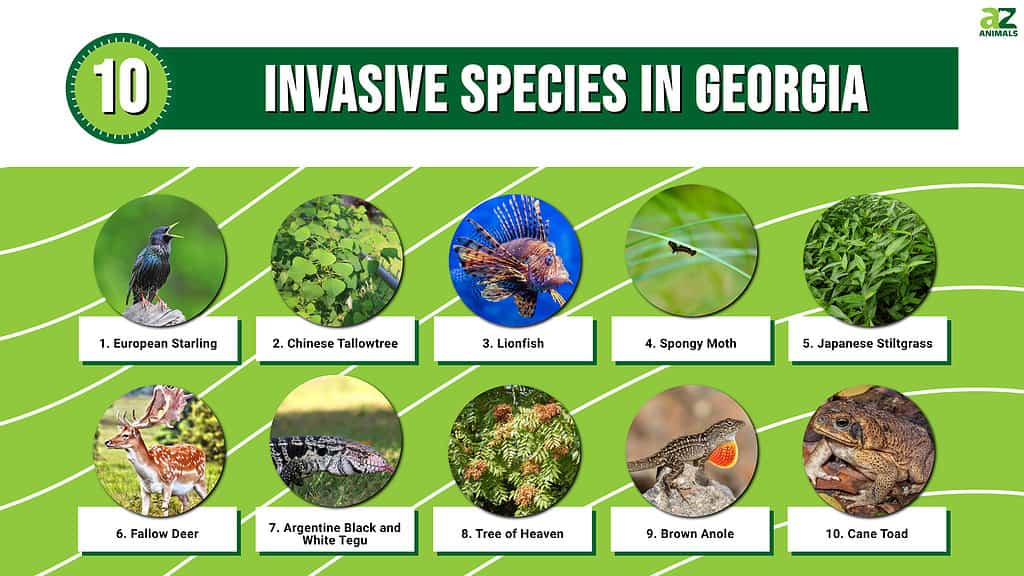
10. Cane Toad

The cane toad is one of the most hated invasive species in Georgia.
©Peter Yeeles/Shutterstock.com
Also known as the marine toad, the cane toad ranks as one of the most vilified species in Georgia. Originally native to South and Central America, farmers first introduced cane toads into Florida to help control sugarcane pests. While these toads originally didn’t keep, an accidental release of cane toads in 1957 eventually led to their eventual spread throughout the southeastern United States, including Georgia.
Cane toads usually measure between 4 and 6 inches long but can reach 9 inches long. They feature dry, warty skin that can appear gray, olive or reddish-brown, or yellow. The toes are webbed, while the fingers are separated.
Cane toads possess poisonous glands that can harm most animals that try to bite or eat them. This makes them relatively safe from predators and allows them to spread almost unhindered. Numerous reports exist of cane toads harming pets, and their poison can even pose a threat to small children.
Cane toads also prey on native fauna and compete with native species for food. Every year they eat large numbers of honey bees, making them a major nuisance to bee-keepers.
9. Brown Anole

Brown anoles outcompete native green anoles in Georgia.
©Natalia Kuzmina/Shutterstock.com
The brown anole also goes by the name the Cuban brown anole or De la Sagra’s anole. As its alternate name implies, this small lizard originally hails from Cuba as well as the Bahamas. Experts believe brown anoles hitched rides on passenger boats and eventually found their way to Florida. From there, they spread north into Georgia, where they have affected native species and habitats.
Most brown anoles appear light or dark brown with tan lines running down the sides. That said, brown anoles can change color, alternating from brown to black. They usually measure 5 to 8.5 inches long.
Brown anoles are more aggressive than the native green anoles in Georgia. This can cause them to outcompete green anoles for food and drive them into trees to escape the ground-dwelling brown anoles. Evidence also suggests that brown anoles are more likely to eat juvenile green anoles than green anoles are to eat juvenile brown anoles.
8. Tree of Heaven

Despite its peaceful-sounding name, the tree of heaven is considered one of the most invasive plants in Georgia.
©guentermanaus/Shutterstock.com
Ailanthus altissima goes by the common name tree of heaven. Originally native to China, this deciduous tree grows rapidly and can survive in almost any environment. Despite its peaceful-sounding name, the tree of heaven is considered one of the most invasive plants in Georgia.
Tree of heaven can grow between 50 and 90 feet tall and live more than 50 years. It features smooth, light gray bark and grows large, pinnately compound leaves. The leaves can grow between 1 and 40 feet and contain anywhere from 10 to 40 leaflets.
Due to its ease and rapid rate of growth, tree of heaven can prevent native plants from growing nearby. It also produces pollen that can cause allergic reactions. Similarly, some people develop skin irritation when they come into contact with its bark, leaves, or seeds.
Moreover, tree of heaven also serves as the host for the spotted lanternfly. This invasive insect destroys native plants across the U.S., where it lacks natural predators.
7. Argentine Black and White Tegu
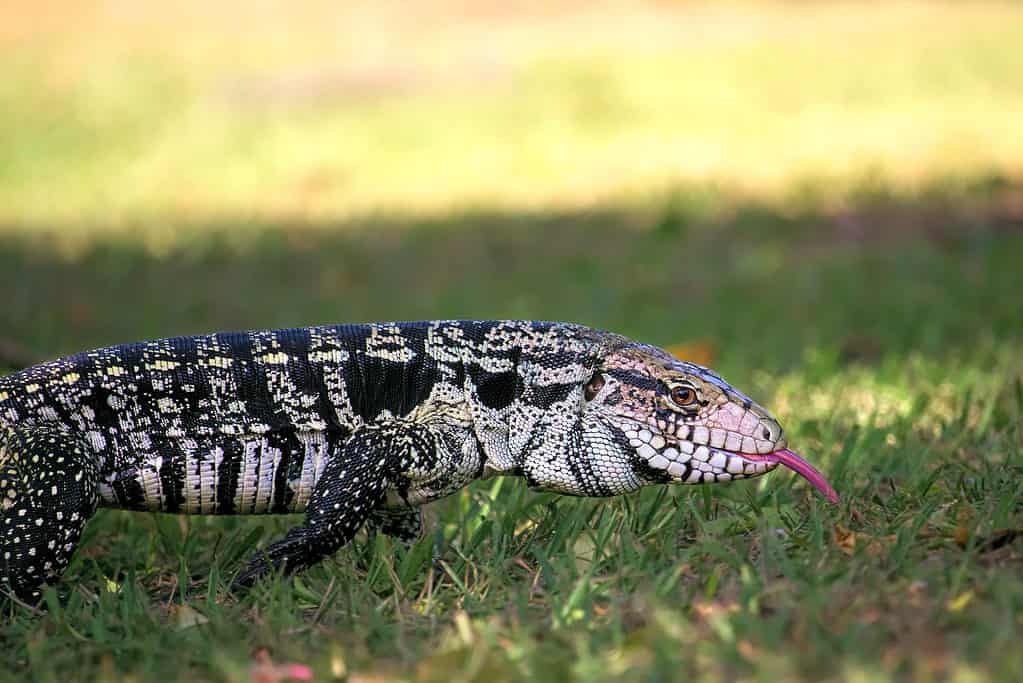
The Argentine black and white tegu can outcompete smaller lizards in Georgia.
©Nelson Donizeti/Shutterstock.com
The Argentine black and white tegu ranks as the largest species of tegu lizard. Found throughout eastern and central South America, these giant omnivorous lizards are highly intelligent and popular in the pet trade. However, since their introduction into the wilds of Florida in the early 2000s, they have spread north into Georgia and now threaten native species.
Argentine black and white tegus can grow up to 4 feet long and weigh up to 10 pounds. As their name implies, their beaded skin consists of black and white dots and stripes. They possess long tails that they can detach, powerful legs, and characteristic chubby cheeks.
Due to their large size, fast rate of growth, and high reproductivity, Argentine black and white tegus have many key advantages that help them as an invasive species. In Georgia, tegus eat the eggs of ground-nesting birds as well as other reptiles. Some experts also worry that they might spread exotic parasites to native wildlife.
6. Fallow Deer
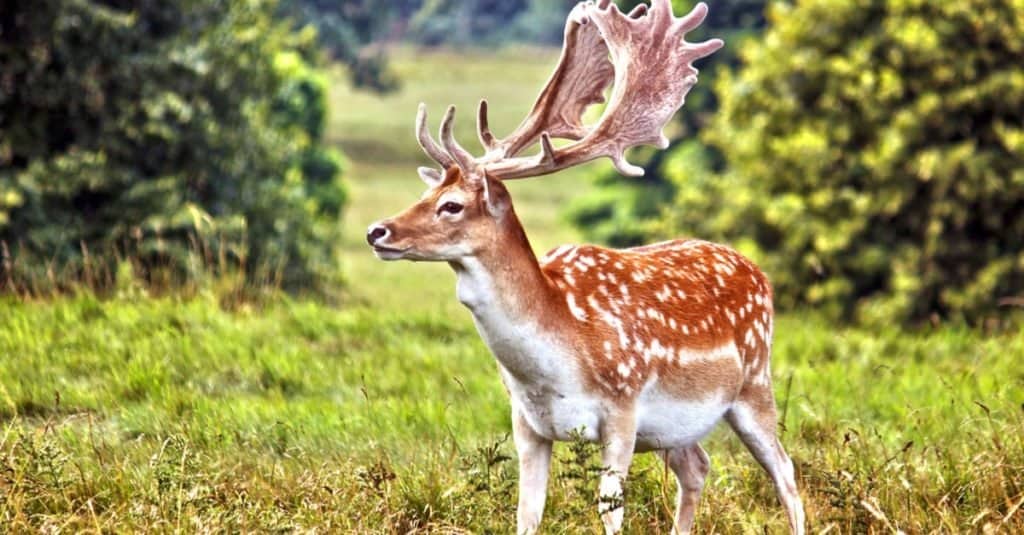
Only male
fallow deer
grow antlers, which appear broad and shovel-shaped.
©Neil Clarke/Shutterstock.com
The fallow deer originally hails from Turkey. It spread to much of Europe and the United States in the 1900s. They arrived on Little Saint Simons Island off the coast of Georgia in 1920, where they eventually proliferated and thrived.
Male fallow deer measure 55 to 63 inches long and weigh from 130 to 220 pounds. Meanwhile, females measure 51 to 59 inches long and weigh from 66 to 110 pounds. They can vary wildly in color from chestnut with white mottles to black to white. Only male fallow deer grow antlers, which appear broad and shovel-shaped.
Since their introduction to Little Saint Simons Island, fallow deer have almost wiped out the native white-tail deer population on the island. Thanks to herd culling, the white-tail deer population now appears stable but still remains far below historical levels. The fallow deer on the island also harm native plants and continue to threaten the balance of the island’s ecosystem.
5. Japanese Stiltgrass
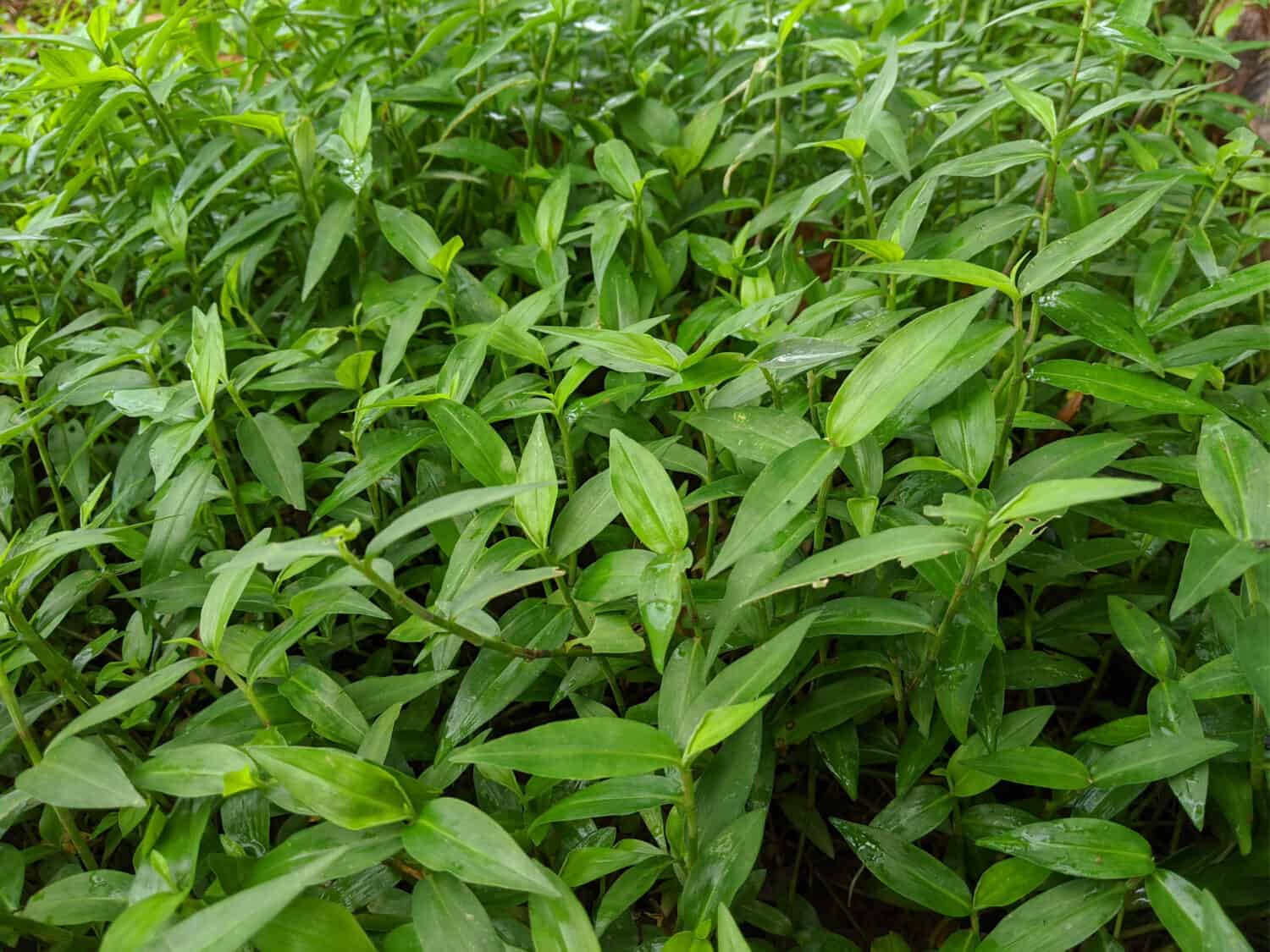
Since many native animals do not graze on Japanese stiltgrass, it can spread almost unhindered and harm ecosystems.
©Zikrieys Ahmad/Shutterstock.com
Also known as Nepalese browntop or packing grass, Japanese stiltgrass is an annual grass that grows in a wide variety of habitats. Originally native to southeast and east Asia, Japanese stiltgrass first arrived in Tennessee around 1919 when it was used as a packing material for porcelain shipments from China. Today, you can find this invasive grass in more than 26 states, including Georgia.
Japanese stiltgrass can grow up to 3.3 feet. In terms of appearance, it looks similar to native Virginia cutgrass. You can tell them apart by the distinctive silver stripe at the center of the Japanese stiltgrass leaf.
Since many native animals do not graze on Japanese stiltgrass, it can grow and spread almost unhindered and harm native ecosystems. Japanese stiltgrass grows well in areas of low light and can reduce the growth of native plants. Its growth can reduce nesting sites for birds and can impact native insects and other wildlife.
4. Spongy Moth

A single spongy moth
caterpillar
can eat around 11 square feet of vegetation during its lifespan.
©iStock.com/Lingkon Serao
Formerly known as the gypsy moth, the spongy moth originally hails from Europe. A French naturalist introduced the spongy moth to North America in 1869 for use in the silkworm industry. Some of the moths escaped from his residence and eventually spread throughout the eastern United States and Canada. Due to the damage they can cause to trees, they are commonly listed as one of the worst invasive species in the world.
Spongy moths lay their eggs on the branches and trunks of trees. The larvae measure around 3 millimeters long when they hatch and appear black with long hair-like setae. They sport raised blue and red spots along their backs. Meanwhile, the adult females appear mostly white, while the males look tan and brown.
Spongy moth larvae feed on over 300 different deciduous tree and shrub host species. They damage trees by consuming most or all of their leaves, preventing trees from photosynthesizing. A single spongy moth caterpillar can eat around 11 square feet of vegetation during its lifespan. Their voracious appetites and high reproductivity make spongy moths one of the most destructive species in Georgia.
3. Lionfish
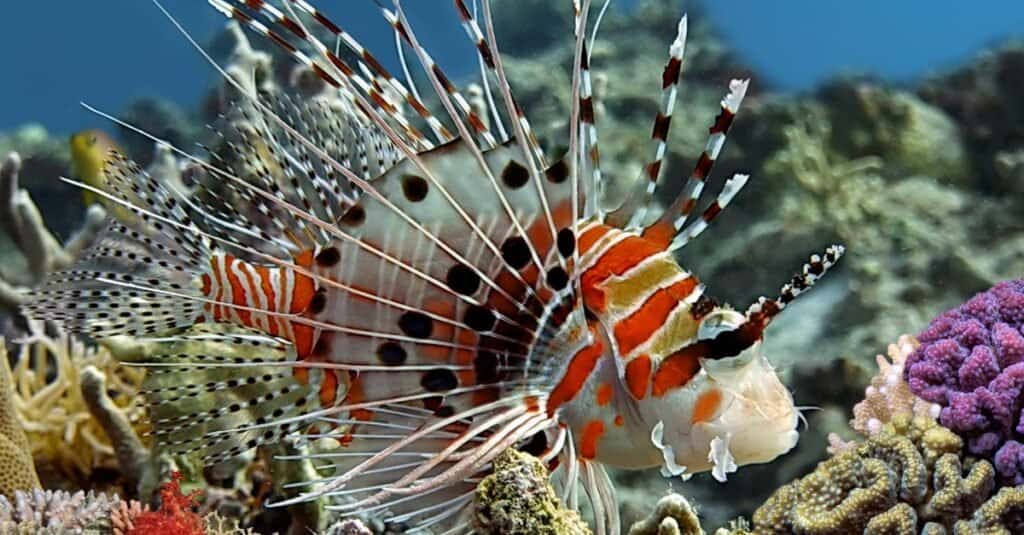
Lionfish
are currently devastating native reef fish off Georgia’s shores.
©Vlad61/Shutterstock.com
The term lionfish refers to fish in the genus Pterois. These venomous marine fish are originally native to the Indo-Pacific. However, following the escape of several lionfish from aquariums, you can now find these invasive fish throughout the Caribbean, Mediterranean, and western Atlantic Ocean, including off the coasts of Georgia.
Lionfish vary in appearance depending on the species. That said, most lionfish appear brightly colored and feature red and white stripes. They sport long spines that radiate from their fins and along their bodies. These spines pack potent venom that protect the fish from potential predators.
Lionfish represent one of the most destructive invasive species to coral reef ecosystems. These super predators can decimate native fish populations and reduce ecological diversity. To combat the spread of lionfish, local governments (including Georgia) do not limit the amount of lionfish that anglers can harvest.
2. Chinese Tallowtree
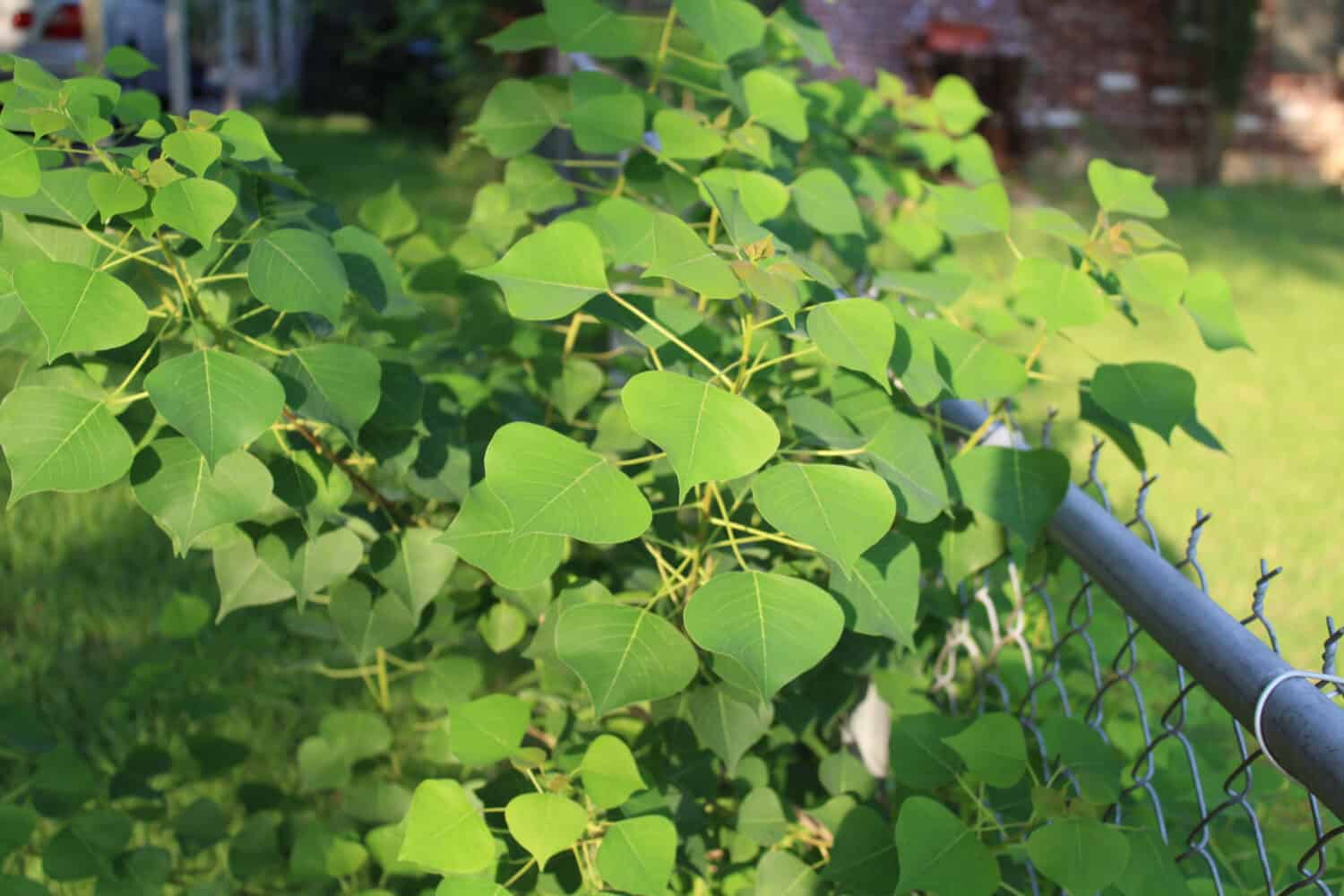
Chinese tallowtree can outcompete native vegetation, threatening the stability and health of ecosystems.
©Wirestock Creators/Shutterstock.com
Tiadica sebifera goes by many names, including Chinese tallowtree, Florida aspen, and candleberry tree. Originally from China and Taiwan, the Chinese tallowtree was introduced to the United States in the 1700s for use in making soaps and oils. Over the past few centuries, Chinese tallowtree has outcompeted native plants in Georgia, creating monocultures that threaten the balance of local ecosystems.
Chinese tallowtree grows waxy, heart-shaped green leaves. In autumn, the leaves turn bright orange, yellow, red, and purple. The tree grows both female and male flowers on the same plant that appear either white or greenish-yellow.
Chinese tallowtree can outcompete native vegetation and threaten the creation of monocultures. This lowers species diversity and threatens the stability and health of ecosystems. Additionally, few predators eat its leaves and berries due to the presence of poisonous compounds. As a result, herbicides and controlled burning represent the only way to control its spread.
Additionally, Chinese tallowtree can also cause skin irritation in some people. Moreover, its decaying leaf litter can alter water quality in the area and negatively impact the growth and development of aquatic organisms such as frogs.
1. European Starling
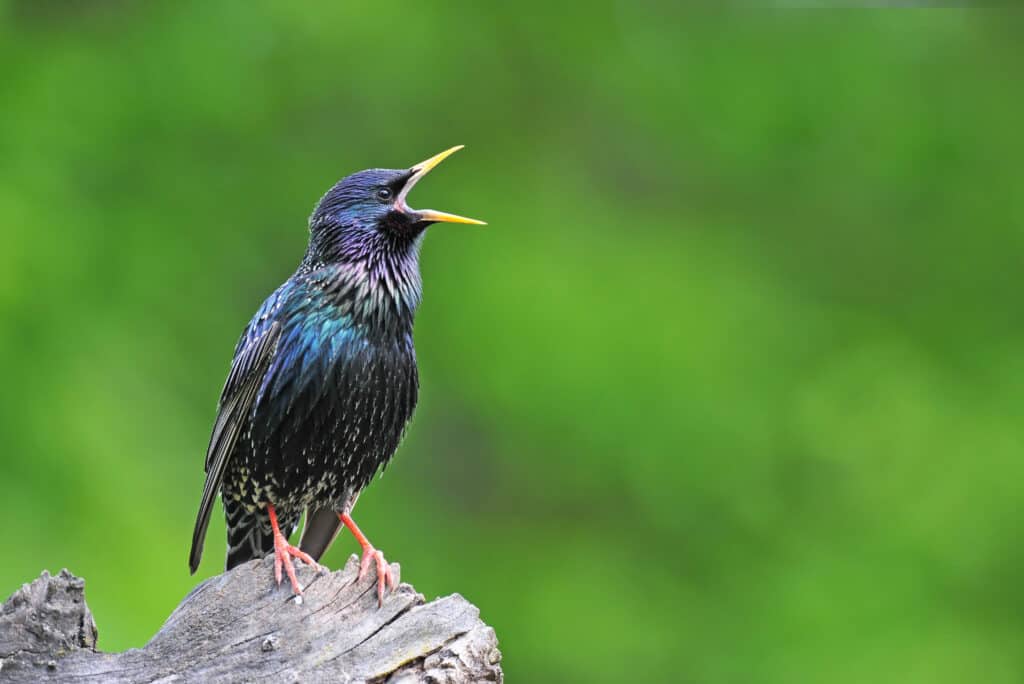
European starlings are one of the most widespread invasive birds in the United States.
©Soru Epotok/Shutterstock.com
The European starling or common starling originally hails from Europe. This small passerine songbird ranks as one of the most successful invasive species in Georgia and North America generally. Its role in reducing native bird populations and damaging agricultural crops make it one of the world’s 100 worst invasive species.
On average, European starlings measure 7.5 to 9 inches long and sport a wingspan between 12 and 17 inches. Their plumage appears iridescent black with purple or green patches and white spangling. In summer, their bills look yellow and then turn dark in winter. They have pinkish-gray legs and dark eyes. People sometimes mistake them for grackles due to their similar plumage.
Although common starlings do help to manage insect pests, they also pose significant environmental problems. They compete with native bird species in Georgia for nesting sites and also can outcompete species such as the woodpecker thanks to their generalist feeding behaviors. European starlings can also damage fruits in orchards, pull up young shoots, and eat crop seeds.
Summary of 10 Invasive Species in Georgia
Here’s a recap of 10 invasive species in the state of Georgia that we took a look at.
| Number | Animal Species | Origin Habitat | Invasive Damage |
|---|---|---|---|
| 1 | European Starling | Europe | Reduces native bird populations and damages agricultural crops |
| 2 | Chinese Tallowtree | China, Taiwan | Outcompetes native vegetation and threatens the creation of monocultures |
| 3 | Lionfish | Indo-Pacific | Can decimate native fish populations and reduce ecological diversity |
| 4 | Spongy Moth | Europe | Damages trees by consuming most or all of their leaves and prevents trees from photosynthesizing |
| 5 | Japanese Stiltgrass | Southeast and east Asia | Can grow and spread almost unhindered and harm native ecosystems |
| 6 | Fallow Deer | Turkey | Have almost wiped out the native white-tail deer population in its habitat and harm native plants |
| 7 | Argentine Black and White Tegu | Eastern and central South America | Eats the eggs of ground-nesting birds as well as other reptiles and may spread exotic parasites to native wildlife |
| 8 | Tree of Heaven | China | Can prevent native plants from growing; produces pollen that can cause allergic reactions; people develop skin irritation when they come into contact with its bark, leaves, or seeds; host for the invasive spotted lanternfly |
| 9 | Brown Anole | Cuba, the Bahamas | Outcompetes green anoles for food and drives them into trees to escape the ground-dwelling brown anoles |
| 10 | Cane Toad | South and Central America | Possesses poisonous glands that can harm most animals that try to bite or eat them, including pets and small children; prey on native fauna including honey bees; compete with native species for food |
The photo featured at the top of this post is © Ondrej Prosicky/Shutterstock.com
Thank you for reading! Have some feedback for us? Contact the AZ Animals editorial team.






